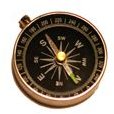If you were watching our course the first day of travel you may be asking yourself why we were doing so many circles on sailing day one. The first thing that popped in to some minds could have been is there a man overboard? The answer to that is no, or another guess could be we are just killing time before we get down to Panama. The answer to that is also no. The reason being for so many circles was because we were “swinging the compass.”
What does that mean?
Well the explanation I received from a few senior marine transportation majors was that because our ship is all steel, the magnetic field in the compass is disturbed by this huge amount of metal. In order to get a true compass reading from the ships compass we had to place magnets inside the compass to correct the error from all of the caused by the steel in the Kennedy. On board the Kennedy and any other ship, there is always a compass if not two or three.
The compass is one of the main tools used for navigation on board the ship. As technology has been progressing through the years so has the equipment we have used on ships. On the Kennedy we use an ECDIS, an Electronic Chart Display, as well as a paper charts (maps) for back up. We also use radar. This is not so much for location but it is used to see land and other ship when weather conditions are poor. In addition, as one could guess we use GPS to help us as well.
The compass is one of the main tools used for navigation on board the ship. As technology has been progressing through the years so has the equipment we have used on ships. On the Kennedy we use an ECDIS, an Electronic Chart Display, as well as a paper charts (maps) for back up. We also use radar. This is not so much for location but it is used to see land and other ship when weather conditions are poor. In addition, as one could guess we use GPS to help us as well.
The fact that this is a training ship, we teach our cadets on how to use a sextant. A sextant is a tool used to measure the stars to find your location. The senior cadets will be learning how to do this in just a few days. These seniors will be training for the entire Seaterm.
This picture shows cadets manning the ECDIS and radar.
In this picture are three cadets on the navigation watch, where they are updating the ships course.
This picture shows cadets manning the ECDIS and radar.
 |

A compass is a device that indicates direction. It is one of the most important instruments for navigation.
Magnetic compasses are the most well known type of compass. They have become so popular that the term “compass” almost always refers a magnetic compass. While the design and construction of this type of compass has changed significantly over the centuries, the concept of how it works has remained the same. Magnetic compasses consist of a magnetized needle that is allowed to rotate so it lines up with the Earth's magnetic field. The ends point to what are known as magnetic north and magnetic south.
 A compass rose is a tool that shows directions on a map. The compass rose has four main directions: North, South, East, and West.
A compass rose is a tool that shows directions on a map. The compass rose has four main directions: North, South, East, and West.
Plot Your Course
Magnetic compasses are the most well known type of compass. They have become so popular that the term “compass” almost always refers a magnetic compass. While the design and construction of this type of compass has changed significantly over the centuries, the concept of how it works has remained the same. Magnetic compasses consist of a magnetized needle that is allowed to rotate so it lines up with the Earth's magnetic field. The ends point to what are known as magnetic north and magnetic south.
 A compass rose is a tool that shows directions on a map. The compass rose has four main directions: North, South, East, and West.
A compass rose is a tool that shows directions on a map. The compass rose has four main directions: North, South, East, and West.
In this inactive you use the compass rose to give or follow directions.
Test your new knowledge with this World Map ActivityPlot Your Course


No comments:
Post a Comment